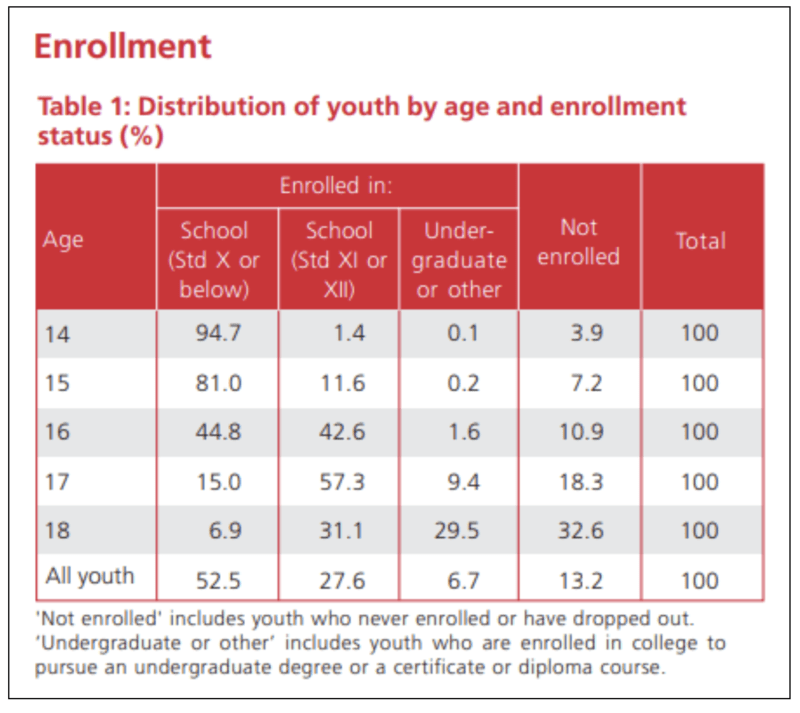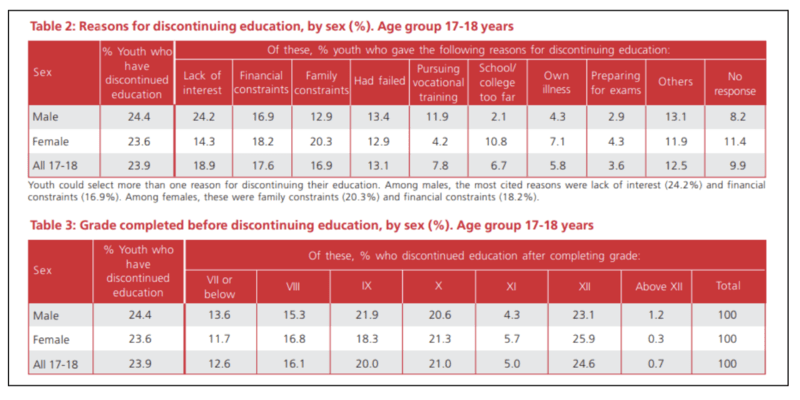ASER 2023 Report
News Excerpt:
ASER (Annual Status of Education Report)’s 2023 survey results show gaps in learning. It focused on 14-to-18-year-old children in rural India, specifically on their ability to apply reading and math skills to everyday situations, and their aspirations.
About Pratham:
- Pratham is a non-governmental organization (NGO) based in India that focuses on education and literacy initiatives.
- The organization was founded in 1994 to provide quality education to underprivileged children in the country.
- Pratham launched the Read India campaign, which aims to improve reading and arithmetic skills among children.
- The organization conducts large-scale assessments, including the ASER, to understand the state of education in rural areas and identify areas for improvement.
About ASER:
- ASER initiated in 2005 and conducted annually until 2014, transitioned to an alternate-year cycle in 2016.
- The core ASER survey focuses on children aged 3 to 16, assessing their enrollment, foundational reading, and arithmetic abilities.
- In 2022, ASER covered nearly 7,00,000 children across all rural districts of India, emphasizing on foundational skills and enrollment.
- ASER expanded its scope in 2017, going 'Beyond Basics' to investigate the activities, awareness, abilities, and aspirations of youth aged 14 to 18 in 28 districts nationwide.
- Despite the Right to Education Act guaranteeing education up to age 14, foundational skill gaps persisted, prompting the need for urgent intervention.
- ASER 2023 aligns with Sustainable Development Goal 4, focusing on inclusive and equitable quality education, addressing targets related to technical, vocational, and tertiary education, digital literacy, and overall literacy and numeracy.
- Changes since 2017, including the pandemic and digital advancements, shape the context for ASER 2023.
- With increased smartphone usage in rural households, the survey explores digital activities and educational smartphone use among youth.
- Covering 34,745 youth in 28 districts across 26 states, ASER 2023 provides insights into educational status, digital engagement, basic skills, and aspirations.
- Despite a decline in out-of-school youth, foundational literacy and numeracy skills show marginal improvement, highlighting persistent challenges.
- The NEP's emphasis on universal FLN by 2025 is acknowledged, but addressing deficits in higher grades remains a challenge.
- The call for a shift from rote learning to critical thinking aligns with ASER's findings, emphasizing a holistic approach to education.
- The ASER 2023 report, titled 'Beyond Basics,' offers a detailed exploration of the lives of 14-to-18-year-olds, portraying their educational journey, digital engagement, and encountered challenges.
Key Domains Explored in ASER 2023 'Beyond Basics':
- Activity: Examining the current engagements of youth, including education, work, and other activities.
- Ability: Assessing foundational skills in reading, arithmetic, and everyday life computations.
- Awareness and Digital Aptitude: Investigating access to smartphones, financial awareness, digital technologies, and the ability to perform basic digital tasks.
- Aspirations: Exploring the aspirations of youth, educational goals, and role models.
- Survey Methodology: It is a sample-based household survey conducted by local volunteers in one or two rural districts per state. The survey retains the core elements of the ASER architecture, aiming to generate evidence about the knowledge and abilities needed by youth.

Key Outcomes of ASER 2023:
- Enrollment Trends and Educational Streams:
- The report underscores that 86.8% of youth in age group of 14-18 are enrolled in educational institutions, emphasizing the progress made in terms of enrollment over the years.
- This is seen as a positive outcome of efforts to increase access to education.
- However, the report suggests that educational institutions might not be effectively delivering foundational skills to students.
- However, significant differences in enrollment rates are observed by age. Notably, 32.6% of 18-year-olds are not enrolled, reflecting challenges in retaining students through their teenage years.
- Choice of educational streams:
- Arts/humanities emerges as the most popular stream among enrolled youth, accounting for 55.7%, while STEM (Science, Technology, Engineering, and Mathematics) follows closely at 31.7%.
- This sheds light on the diverse academic interests and aspirations of rural youth, hinting at the need for a flexible and inclusive education system.
- Math and Reading Proficiency:
- Basic math skills are a concern, with only 43.3% of 14-18-year-olds able to correctly solve division problems (3-digit by 1-digit), a skill usually expected in third and fourth grade.
- The survey reveals that while 85% can measure length using a scale when the starting point is 0 cm, this proportion drops significantly to 39% when the starting point is moved.
- Close to 50% can perform other common calculations such as calculating time, adding weights, and applying the unitary method.
- The report's revelation that 40% of youth in this age group cannot read sentences in English underscores the need for targeted interventions to enhance language proficiency.
- The report indicates that a significant percentage of students cannot read Class-II-level text fluently in their regional languages, have limited English proficiency, and struggle with basic math problems.
- This gap in foundational skills may hinder the students' future prospects in the labour market and impede their ability to pursue higher education or professional training.
- Digital Access and Literacy: In an era defined by digital transformation, the ASER 2023 report explores the digital landscape of rural youth.
- Nearly 90% of surveyed households have smartphones, indicating widespread access to digital technology.
- While there is a high level of familiarity with basic smartphone usage, 52% lack knowledge of online safety, affecting tasks like reporting/blocking profiles and managing passwords.
- Only 9% have a computer/laptop at home, impacting digital skills.
- Approximately 90.5% of youths use social media, with males slightly more likely to know about online safety settings.
- Two-thirds of smartphone users reported engaging in educational activities, indicating digital learning adoption.
- Nearly 80% use smartphones for entertainment purposes.
- The report highlights a surface-level engagement, primarily centered around social media.
- The report's findings suggest an opportunity to cultivate a more profound set of digital skills among young people, extending beyond social media engagement.
- Challenges in Basic Life Skills:
- A considerable portion, approximately 30%, is already engaged in various activities, often working to support their families. However, their aspirations extend beyond these current engagements, indicating a mismatch between their current situations and future aspirations.
- The findings underscore the significance of basic life skills, revealing that proficiency in reading and math is integral even for everyday tasks.
- The report challenges the notion that struggling students in higher classes should be overlooked, emphasizing the importance of reaching out to them to bridge the learning gaps.
- Despite longer school durations, foundational skills haven't significantly improved since 2017. For instance, the ability to read a Std II level text slightly decreased from 76.6% (2017) to 73.6% (2023).
- Gender Disparities:
- Humanities are more popular among females (60.6%), while STEM is favoured more by males (36.3%).
- Females outperform males in reading a Standard II level text in their regional language (76% vs. 70.9%).
- Boys not only have greater access to smartphones but also outperform girls in digital tasks. Males are more likely (43.7%) to own smartphones compared to females (19.8%).
- The gender disparity in math and reading skills is evident, with boys outperforming girls in arithmetic and English reading tasks.
- In terms of household responsibilities, the report indicates that 86% of females reported being involved in domestic work, compared to 66% of males.
- This digital gender gap raises concerns about the equitable integration of technology in education.
- Vocational Training and Aspirations:
- The ASER 2023 report reveales that only 5.6% of youth aged 14 to 18 are currently engaged in vocational training or related courses with a preference for short-duration courses.
- In a world driven by skills, a deficit in education can exacerbate inequality and hinder the nation's competitiveness.
- The majority of participants in such programs are enrolled in short-duration courses lasting six months or less, indicating a potential gap in the availability and awareness of vocational training opportunities.
- The vocational choices made by youth often align with the educational offerings in their localities.
- The Role of Schools and Beyond:
- While school enrollment provides an opportunity to reach a significant portion of the youth population, the report emphasizes that the effectiveness of education extends beyond the traditional classroom setting.
- Face-to-face classroom learning is just one mode, and leveraging information about the target audience can open avenues for diverse learning methods. As the majority of respondents in Class 11 or higher were studying humanities-related subjects, questions arise about their prospects in a job market that traditionally values STEM knowledge.
- The report suggests that the New Education Policy of 2020, with its emphasis on flexibility, could be instrumental in providing students with alternatives and expanding their learning opportunities.
- Policy Implications: The analysis suggests a shift in focus from enrollment challenges to learning outcomes.
- The questions raised at the policy level include whether there is a shortage of teachers, if teachers lack proper incentives, the need for better monitoring systems, and whether teachers are adequately trained. Addressing these questions is crucial to enhancing learning outcomes and preventing a scenario where inadequate education contributes to inequality and undermines growth and development goals.

Key Recommendations Include:
- Focused Remedial Education: The prevalence of learning gaps among youth underscores the need for targeted remedial education. Implement remedial programs that address specific learning deficiencies, leveraging technology and community resources to provide personalized support.
- Gender-Inclusive Education Policies: There is a need to implement gender-inclusive education policies, along with targeted interventions to enhance digital literacy among girls, promoting equal opportunities in education.
- Career Counseling and Vocational Training: Strengthen career counseling services, introduce vocational training aligned with local employment needs, and create awareness about non-traditional career paths to broaden horizons.
- Digital Literacy Promotion: Initiate programs to provide affordable digital devices, promote comprehensive digital literacy, and develop engaging content relevant to the educational needs and interests of rural youth.
- Skill Development and Apprenticeships: Introduce skill development programs aligned with market demands, enhance vocational education, and foster collaboration with local industries to create apprenticeship opportunities for practical learning.
- Tailored Regional Interventions: Customize educational interventions to address region-specific challenges, invest in infrastructure, and encourage community involvement to ensure relevance and effectiveness.
- Empowering Aspirations: Launch awareness campaigns challenging stereotypes, involve local communities in discussions on gender equality, and advocate for policies supporting educational aspirations beyond traditional roles.
- Comprehensive Digital Literacy and Safety: Integrate digital literacy training into the curriculum, conduct awareness programs on online safety, and involve parents and communities in promoting responsible digital behaviour.
- Flexible Learning Pathways: Introduce flexible learning pathways, showcase the benefits of higher education, and establish mentorship programs to guide students in making informed decisions about their educational and career paths.
- Financial Literacy Programs: Integrate financial literacy education into the curriculum, provide hands-on training in financial management, and collaborate with financial institutions for outreach programs to enhance financial literacy skills.
Way Forward:
- As a country, we need to equip our young people adequately with the essential knowledge, skills, and opportunities they need to drive their own progress and that of their families and communities. India’s anticipated “demographic dividend” and “digital dividend” can achieve their full potential if this is done.
- The snapshots of the digital — and other educational — capabilities of youngsters in ASER 2023 could provide cues to policymakers in implementing NEP’s visions. At the same time, they should also remain alert against lapsing into technological fundamentalism.
Conclusion:
The ASER 2023 report prompts a reflection on the effectiveness of current educational initiatives and the need for adaptive strategies that resonate with the dynamic aspirations of the youth in rural India. It illuminates the need for targeted interventions to enhance foundational skills, bridge gender disparities, and align educational offerings with the diverse aspirations of rural youth.


